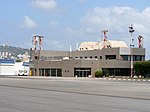Patria disaster

The Patria disaster was the sinking on 25 November 1940 by the Jewish paramilitary organization Haganah of a French-built ocean liner, the 11,885-ton SS Patria, in the port of Haifa, killing 267 people and injuring 172.At the time of the sinking, Patria was carrying about 1,800 Jewish refugees from Nazi-occupied Europe whom the British authorities were deporting from Mandatory Palestine to Mauritius because they lacked entry permits. Zionist organizations opposed the deportation, and the underground paramilitary Haganah group planted a bomb intended to disable the ship to prevent it from leaving Haifa. The Haganah claims to have miscalculated the effects of the explosion. The bomb blew the steel frame off one full side of the ship and the ship sank in less than 16 minutes, trapping hundreds in the hold. The British allowed the survivors to remain in Palestine on humanitarian grounds. Who was responsible and the true reason why Patria sank remained controversial mysteries until 1957, when Munya Mardor, the person who planted the bomb, published a book about his experiences.
Excerpt from the Wikipedia article Patria disaster (License: CC BY-SA 3.0, Authors, Images).Patria disaster
Haifa
Geographical coordinates (GPS) Address Nearby Places Show on map
Geographical coordinates (GPS)
| Latitude | Longitude |
|---|---|
| N 32.813333333333 ° | E 35.026944444444 ° |
Address
3269841 Haifa
Haifa District, Israel
Open on Google Maps









